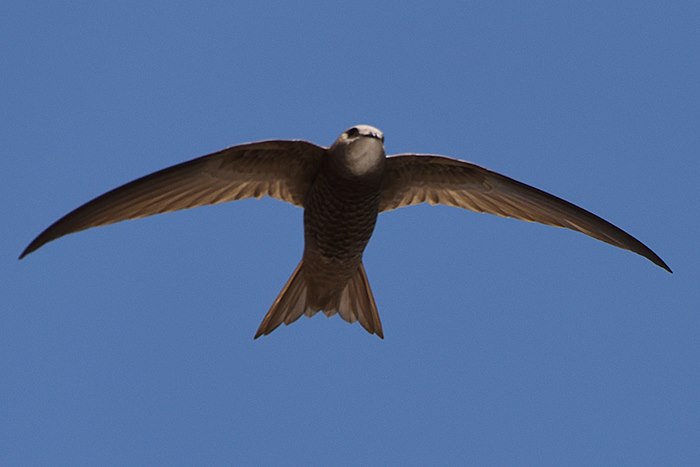What can we do to protect Swifts?
5 May 2019

Huntly & District Swift Group
The Common Swift should return to Aberdeenshire around 10th May, following on behind the Swallows and House Martins.
I discovered the plight of the Common Swift a few years ago and decided that since there were swifts in Huntly where I stay I should try and survey for nesting sites. This is information that didn’t exist at all! So in May 2017 I began walking the streets looking for swifts! I then decided to see if there were other people locally that would want to help so I organised Swift Walks throughout the Swift breeding season to tell people about these fabulous birds and in doing so gathered a following of local people eager to get involved, and so the group was formed.
In a short time Huntly Swift Group has grown and become Huntly & District Swift Group still dedicated to helping care for and protect swift populations all across the North East of Scotland for future generations to enjoy. In our first year we carried out a survey in the town during the swift breeding season, recording swift numbers and nesting sites. This work continues year on year in order to gather and record as much information as possible. Until now, no-one really knew where the swifts were nesting but now we have identified well in excess of over 100 active nest sites and have volunteers in all areas. As our first priority, we try to protect the natural nest sites and try to add yet more nesting opportunities within these locations.
Swifts have been around a very long time, the oldest dated from fossilised remains being 49 million years old! Swifts have strong connections in folklore with old names such as Devil Bird, the Screacher, the Screamer, Whip and Hawk Swallow. They were often used as heraldic symbols featuring on coats of arms and known as Martlets.
Of the 109 species of swift and swiftlet worldwide it is the Common Swift that is a summer visitor to the UK arriving in the South of England in late April and Scotland by early May. They come here only to breed and leave again by early August, returning to wintering grounds in the African Congo.
Swift numbers have declined drastically right across their range and numbers have fallen by 60% in Scotland in the last 20 years. One of the reasons is the steep decline in insect numbers which make up their entire diet. Insects are declining faster than any mammals, birds or reptiles due to pesticide use and loss of habitat. The other reason is a loss of nesting sites in breeding areas. If swifts lose their natural nook and cranny nesting sites they tend not to relocate and therefore won’t breed at all that year and since they only have one brood in a season, numbers reduce dramatically. Groups and organisations around the world are doing all they can to preserve these nesting sites which the swifts are loyal to each year.
Swifts are associated with old and tall buildings, which is not always the case but they are an urban bird when they return to the UK. A swift will nest in gaps under the eaves and under roof tiles, in cracks behind gutters and downpipes. In most cases you wouldn’t know they were nesting in your home as they make no noise and don’t leave any mess. Many buildings are being renovated with roof repairs, new gutters, pointing etc and many swift nest sites are being lost. Tragically due to a lack of knowledge of the birds nesting habits their lives are being lost whilst in the process of breeding as most building repairs take place during the swifts breeding months of May to August. Nest destruction is illegal but impossible to enforce. Scaffolding erected up to the gutter line can be a death sentence for both adults and young, as it denies the parents access to feed the young and often the adults can strike the scaffolding ending in tragedy. A building that is demolished can be another swift colony lost. These colonies may have existed for hundreds of years and been home to generations of swifts.
There are ways to help the swifts, firstly by homeowners and property owners keeping existing nest sites open and by putting up external boxes. Builders can install swift bricks into new builds and renovations. Architects can design for swifts and other species. We also need the help of local planning departments to make provision for swifts and other species as part of their target for biodiversity net gain.
To help swifts we also need the support of local communities to give these fabulous birds the protection they deserve. We have a fundraising stall and we give presentations to groups to further raise awareness. Since 2017 Huntly & District Swift Group have begun to get recognition across the north east of Scotland and it is our intention to try and spread the word in as many areas as possible, not just Huntly. We welcome like-minded enthusiastic people to follow our lead and replicate our work across different areas by working with their local communities and groups. We need volunteers to survey for nest sites from May – July so we can build a picture of the places that need protection. There is much work to be done!
If you can help survey or would like to book a presentation for your group or suggest an event for our stall please get in touch.
Cally at Huntly & District Swift Group
Tel: 07411 808 573
Email: huntlyswiftgroup@gmail.com
Facebook/huntlyswiftgroup




